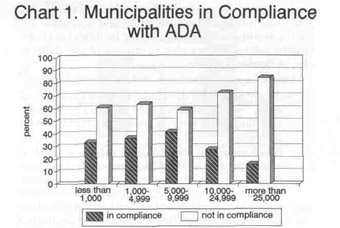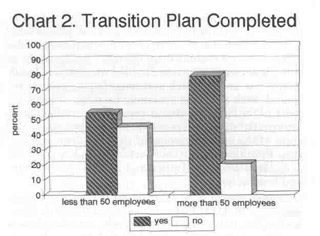|
MEETING ADA DEADLINE CAN BE DIFFICULT
By ROBIN JOHNSON and NORMAN WALZER
In January, 1995, all local governments across the
United States face an important deadline for compliance with the Americans With Disabilities Act
(ADA).
In Illinois, and probably many other states, municipalities will not meet the deadline and some will not be
in compliance for several more years due to cost factors. These were the preliminary findings of a survey of
Illinois municipalities commissioned by the League, the
Local Government Affairs division of the Office of the
Comptroller and the Illinois Institute for Rural Affairs
(IIRA) at Western Illinois University.
Surveys were mailed to all 1,282 municipalities in
Illinois. As of December 15, there were 406 responses
received for a 31.7 percent response rate. Additional
responses are still being tabulated. Final results will be
available in early 1995. The average respondent population is 9,460. Fifty-five percent of municipalities responding are from metropolitan counties and 45 percent are from nonmetropolitan counties.
The survey gathered information on compliance
efforts by municipalities in Illinois, the associated costs
involved, innovative management approaches and attitudes of municipal officials toward ADA. This article
describes compliance efforts and procedures. Future
articles will describe other ADA compliance issues examined in the survey.
Survey Findings. More than 60 percent of cities and
villages responding report they will not have all structural modifications to municipal buildings and services
completed by January 1995. Compliance rates are
lower in large cities. More than 80 percent of municipalities with a population over 25,000 will not be in compliance (chart 1).
"For most cities and villages in Illinois, especially
large cities, the cost of complying with ADA has prolonged efforts to meet the deadline," said Ken Alderson, Executive Director of the Illinois Municipal
League. "Confusion over the Acts' mandates have also
hurt compliance efforts among small towns."
Large cities are more likely to have a variety of
buildings and services to make accessible. Compliance
will take longer and be more expensive for them. Small

Source: ADA Survey of Municipal Governments, Fall 1994.
|
towns, in many instances, have few, if any, physical
structures to renovate. This may explain the differences
in compliance rates between large and small cities.
The survey listed 18 structures (curb ramps, stairs,
entrances, etc.) involved in making facilities and services accessible. Respondents were asked whether the
structural issue applied to them, their stage of compliance, and whether they were in compliance currently. Overall, 32.4 percent were already in compliance or completed the accessibility projects, with 13
percent reporting the projects almost complete.
Another 22.6 percent believe the elements do not apply
to them. Nearly 16 percent say the review of facilities is
still in progress and 16 percent report little or no action
currently underway. Municipalities are most likely to
have made parking, entrances and corridors and aisles
completely accessible to the disabled.
|
"The results are not surprising. Parking and entrance
accessibility are the most visible and symbolic examples of making services available to disabled people,"
said Vickie Wilson, Program Director of the Coalition
of Citizens with Disabilities in Illinois. "You have to get
into the building before you can access services and
programs."
ADA was enacted in 1990 and prohibits discrimina-
January 1995 / Illinois Municipal Review / Page 11
tion against disabled people in employment, public
services, public accommodations and telecommunications. Under Title II of the Act, all programs, services
and activities provided by local governments must be
made accessible to disabled people by January 26,
1995. The Act provides procedures and timetables for
local governments to evaluate their facilities for accessibility and to create a plan to remove physical obstacles to disabled people.
Other important findings of the survey include:
—Awareness. Most municipal officials are aware of
ADA. Nearly 90 percent of officials responding
said they were very or somewhat familiar with
the Act;
—Involvement of the disabled. About a third of
municipalities in the survey report having residents with disabilities involved in the transition
process. Larger cities are more likely than smaller
towns to include disabled residents. ADA advocates recommend that disabled people have a
role in the process to relate their experiences and
suggest creative and low-cost methods of compliance.
—Prioritization. More than 75 percent of municipalities prioritized the structural changes required
by the transition plan in order of importance.
Priortization was recommended by state local
government organizations as a way to make
compliance more coordinated and efficient.
Municipalities in Illinois have made facilities and
services accessible to the disabled for many years in
response to federal and state disability mandates. On
the federal level, Section 504 of the Rehabilitation Act
of 19731 prohibits recipients of federal funds from discriminating on the basis of handicap. In Illinois, the
Environmental Barriers Act2 requires that newly-constructed facilities, additions to facilities and alterations to facilities meet specific accessibility guidelines.
ADA goes further by creating regulations and standards
for compliance and implementation in existing facilities
and codifying administrative regulations designed to
implement earlier laws.
Most municipalities have made structural changes
as part of ordinary replacement of services and other
programs. For example, under sidewalk improvement
plans, cities can install curb ramps for disabled people
at little or no additional cost. The survey revealed that
municipalities, on average, have completed approximately 35 percent of structural changes as part of ordinary replacement.
Making programs accessible does not necessarily
involve structural changes and increased expenses.
"Reasonable accommodations" may mean simply a
change in policy or providing services and programs at
different locations. For example, Lake Forest officials
moved their City Council meetings to a local school
after a wheelchair-bound citizen could not obtain access to the upstairs council chamber because the building had no elevator.3
According to the survey, the main reason given by
municipalities for not being in compliance is cost, with
nearly 70 percent citing financial considerations. Approximately one in four cities report insufficient time to
comply fully. Larger cities are more likely to cite time
Page 12 / Illinois Municipal Review / January 1995
considerations as a reason for non-compliance. Cost
factors will be explored in more detail in a later article.
In small communities, local officials are less familiar
with the law or may not have the same expertise and
resources available as in larger cities. In some cases, the
law may be seen as vague and an "unfair, unfunded"
federal mandate. Without an attorney or human resource director to advise on how to comply, these
communities may not act as quickly as larger cities.
Future Problems? Municipalities that have not followed the process authorized by ADA may face problems in the future. ADA created a compliance process
that includes a self-evaluation and transition plan. The
self-evaluation identifies changes in programs and policies needed to comply with ADA. A committee of
residents from each municipality was responsible for
completing the self-evaluation by January 26,1993. The
transition plan provides a timetable for implementing
recommended structural changes. While local governments had to prepare a transition plan, only those with
|
50 or more employees were required to prepare and
maintain a written plan. Local governments with fewer
than 50 employees, however, were urged to create a
written plan to demonstrate, if challenged, a good faith
effort to comply with ADA.
According to the current survey, nearly 75 percent
of municipalities completed the self-evaluation and
nearly 61.8 percent prepared a transition plan. Only 20
percent of municipalities with more than 50 employees
have yet to complete a transition plan as required but 45
|

Source: ADA Survey of Municipal Governments, Fall 1994.
|
percent of those with fewer than 50 employees have not
completed one (chart 2). Compliance with both requirements varies with size and smaller towns are less
likely to be in compliance than larger cities.
Municipalities that have completed the transition
plan are slightly more likely to be in compliance with
ADA by the deadline according to survey results. Also,
those cities not completing a transition plan were more
likely to view ADA compliance as more difficult than
expected. Municipalities, large and small, that have not
completed a transition plan may face substantial expense if a resident or other group files a complaint.
January 1995 / Illinois Municipal Review / Page 13
The outcome in municipalities that have followed
the process but are not yet in compliance, is less clear.
ADA tries to balance the rights of the disabled and the
rights of those regulated by the Act. The mandate to
provide accessibility to the disabled was tempered with
conditions under which accommodations are not required, such as undue economic hardship. The ambiguity of the language almost ensures that conflicts over
interpretation will necessitate Judicial remedies, despite ADA'S encouragement of alternate dispute remedies. Penalties include court action by individuals, the
U.S. Department of Justice and possible loss of state
and federal funding.
Some courts have taken a rigid stance on compliance with ADA. For example, city officials in Manhattan, KS, planned a $200,000 curb ramp installation
program during a four year period, believing that the
January 1995 deadline was for completing the transition
plan only, not completing the work. A district court
judge disagreed, ruling in July, 1994, that ADA required
all the city's planned curb ramp work be done by the
1995 deadline.4 The decision resulted in three full-time
crews, one part-time crew and contractual employees
working to meet the deadline.
City officials in Philadelphia, PA, interpreted ADA
as requiring curb ramps only when building new streets
or reconstructing streets, not during resurfacing. The
Supreme Court in April 1994 upheld a lower court
ruling requiring the city to install curb ramps on resurfaced streets also.5 Not only must the city install curb
ramps on all streets it plans to resurface in the future, it
must replace curbs with ramps on all streets resurfaced
since January 26, 1992, the date ADA went into effect.
Illinois municipalities not in compliance, but with
transition plans in place, should hope that courts adopt
a more lenient attitude. With many structural improvements completed or in progress, local officials
believe they are making a good-faith effort to comply
with ADA.
Wilson, the Coalition of Citizens With Disabilities in
Illinois director, which has approximately 1,500 members statewide, does not expect a rash of complaints
after the compliance deadline. "We encourage our
members to work with local governments as much as
possible. Complaints to force compliance are used only
is a last resort."
Compliance efforts will continue in most municipalities after the deadline. Officials from towns of less than
25,000 people estimate they will need on average, four
more years to fully comply while officials from cities
over 25,000 in population estimate about five and a half
more years, according to the survey.
While there is visible progress in many communities, such as ramped sidewalk curbs, modified entrances and handicapped parking spaces, much work
remains to be done. Full compliance with ADA will
continue to challenge municipalities for years to
come. •
1. Stephen L. Percy, "The ADA; Expanding Mandates for Disability
Rights," Intergovernmental Perspective, (Winter 1993), pg. 1.
2. Illinois Compiled Statutes, Ch. 410, Section 25/1 et seq.
3. Monica Fountain, "Accessibility Boils Down to Cash," Chicago Tribune, December 5, 1994, pg. 7.
4. David Fleming, "Cities Scramble to Meet Curb Dadline," Peoria Journal Star, August 28, 1994, pg. A10.
5. Ibid.
Robin Johnson is an administrative assistant with the Local Government Affairs Division of the Office of the Comptroller. Norman
Walzer is director of the Illinois Institute for Rural Affairs at Western
Illinois University.
14 / Illinois Municipal Review / January 1995
|